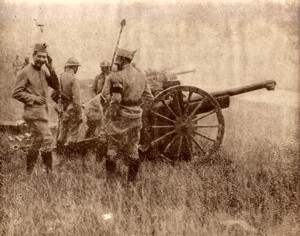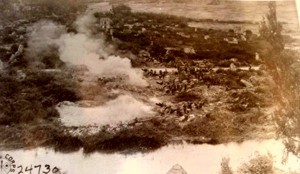World War 1
Field Artillery
The Official "Last Shot" photo
November 11, 1918 armistice signed, our guns ceased firing at 10:55 A. M. although the Germans fired for eight minutes after we had received orders to stop. Two men were killed and one wounded in the last eight minutes of the war.”
The boys fired the last shot from a canon outside of Versailles just after the Peace Treaty was signed. This will always mark the end of the great world war.
National Archives Photo, courtesy of Indiana War Memorial Archives
Artillery was Trench Warfare and was a major factor in WW1. Light Field Artillery was pulled by horses, Howitzers and heavier guns were moved with tractors. Newly developed high explosive shells could be thrown farther and higher than ever before. The heavy reliance on artillery fire left the war stalemated in the trenches. Artillery shells were first used by the Germans in 1915 and soon after adopted by the Allies.
Battery C, 108th Field Artillery firing a salvo at retreating Huns, from the ruins of an unidentified city in France.
Photo courtesy of Indiana War Memorial Archives
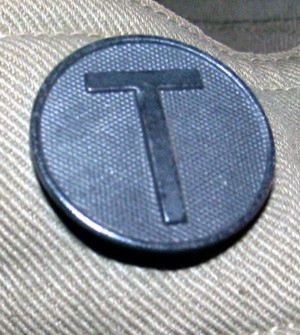
WWI Collar Insignia for Field Artillery Ammunition Supply Train Co.
Indiana War Memorial Archives
![Photograph of a large U.S. Army field artillery gun firing at the training area at Fort Bragg, N.C., around the 1920s [circa 1920s]. Photograph of a large U.S. Army field artillery gun firing at the training area at Fort Bragg, N.C., around the 1920s [circa 1920s].](https://wwvets.org/wp-content/uploads/2020/08/FAPhotograph-of-a-large-U.S.-Army-field-artillery-gun-firing-at-the-training-area-at-Fort-Bragg-N.C.-around-the-1920s-circa-1920s.-1.jpg)
Stories from the veterans:
Phillip J. McCauley, Captain, Artillery, Tippecanoe County, Indiana
Entered service in April 1918. Stationed at Ft. Snelling, Minn. Sent to Ft. Sill, Okla., where he acted as an instructor. Transferred to Camp Mills, N. Y. Saw active service in France. Was decorated by General Pershing for brave and gallant fighting in the Luneville sector, France. While in the battle of Chateau-Thierry, his horse, which he brought from St. Paul, was shot from under him. He had a narrow escape from death. In August 1918, he was appointed Secretary of the Officers’ Artillery School at Bordeaux, France, the largest training school for artillery officers in the world. Born at Lafayette. Ind., July 9, 1882, son of Mrs. Annie E. McCauley. Wife is Genevieve McCauley. Home is St. Paul, Minn.
Photograph of a large U.S. Army field artillery gun firing at the training area at Fort Bragg, N.C., around the 1920s [circa 1920s].
US Signal Corps photo
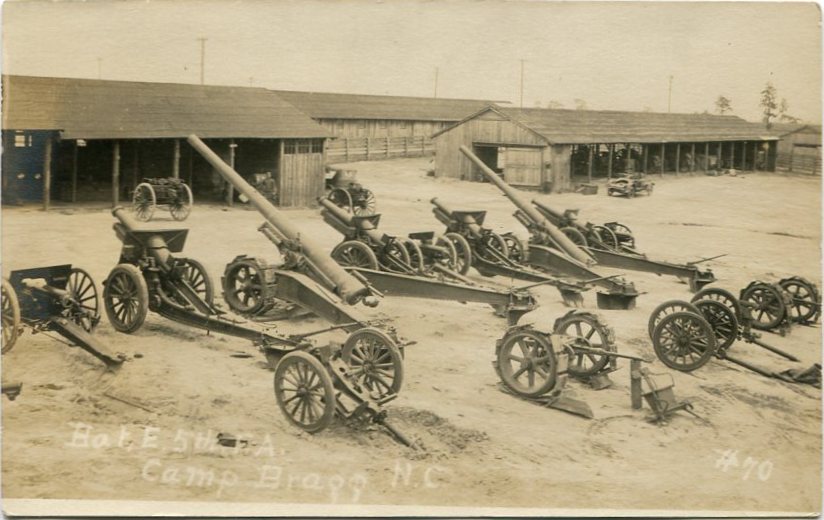
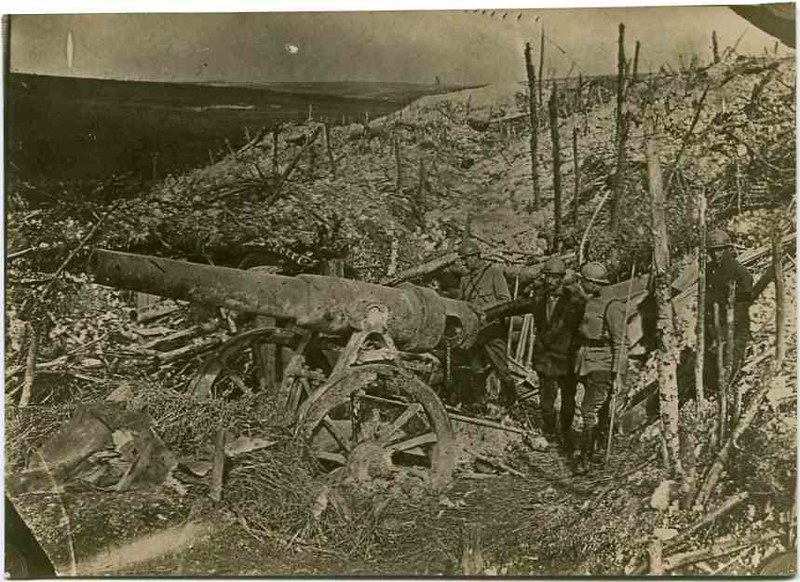
View of French Army soldiers, wearing Adrian helmets, and two unidentified military personnel, standing around a captured, camouflaged German artillery gun, seen on an artillery-damaged hill, north of Pont-à-Mousson, France (circa 1918) Photograph collected by Henry L. Graves.
US Signal Corps Photo
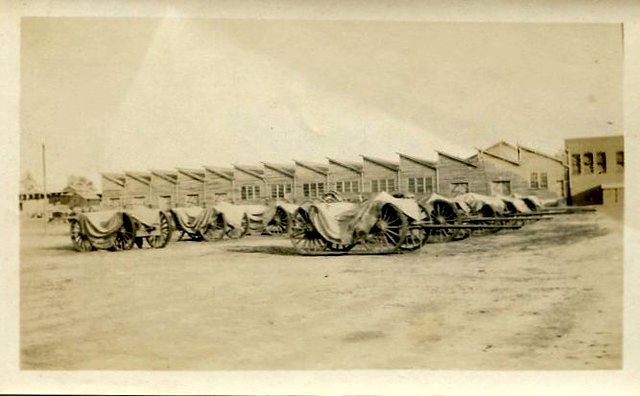
Snapshot of a large group of covered wheeled field artillery guns parked outside of the laundry building at Camp Jackson, S.C., around 1918 during World War I. Photograph taken or collected by Willie H. Mann of Chatham County, N.C., while he was stationed in the 81st Infantry Division, U.S. Army, at Camp Jackson [circa 1918]
US Signal Corps photo
![Photograph of a U.S. Army 240mm howitzer, with its barrel raised up, amid a stand of trees at Fort Bragg, N.C., around the 1920s [circa 1920s]. Photograph of a U.S. Army 240mm howitzer, with its barrel raised up, amid a stand of trees at Fort Bragg, N.C., around the 1920s [circa 1920s].](https://wwvets.org/wp-content/uploads/2020/08/FAPhotograph-of-a-U.S.-Army-240mm-howitzer-with-its-barrel-raised-up-amid-a-stand-of-trees-at-Fort-Bragg-N.C.-around-the-1920s-circa-1920s..jpg)
Photograph of a U.S. Army 240mm howitzer, with its barrel raised up, amid a stand of trees at Fort Bragg, N.C., around the 1920s [circa 1920s].
US Signal Corps photo
R. C. Hufford, Sergeant Major, Field Artillery, Jefferson County, Indiana
“All in all, there's something about the artillery game that makes it the most interesting and the most fascinating of all.
“For instance, when can you stand beside a convenience hole (for safety's sake) and watch the various operations and get an impression of how wonderful, and at the same time, how devilish, are the forces of play. Off to the front are flares and searchlights, with darting stars behind and between.
“There are the infantry and close-up organizations; in back of them, around and behind, are the intermingled flashes and roars of the various size heavy pieces, mixed with these are the whispers of the shells sent Hun-ward, and the growing tone of the arrivals that are bursting everywhere.
“Overall of this, one hears various types of planes, with their machine guns cutting in, slashing each other, or darting slivers of death at the carotid trenches below.
“A growler comes over, someone yells ‘gas’, and you adjust your mask, and have not missed a bit of the great activity. Messengers are darting hither and dither, linemen are going out, ambulances are pushing forward, trucks are crowding foreword and to the guns with the needed supplies, for communication must be kept, the wounded cared for, the fighter fed, and supplies kept up all the time that the Master Dealer is shuffling the deck and dealing each man his card ~ and to many of each side, he deals the marked card, Death.
“Gradually the noise dies down, and only the distant intermittent spat of rifle and pistol is heard. The battle is over, day breaks, and the work of repairing and burial follows.”
Edward Norman Schwamburger, Corporal, Co. B, 6th Infantry, 5th Div., Vanderburg County, Indiana
Awarded the Croix de Guerre for rushing through shell fire and delivering a message, August 18, 1918, by the French. Awarded Distinguish Service Cross for rescuing a comrade during a heavy bombardment.
Gassed, August 18, 1918. Bayoneted through neck September 12, 1918, and gassed in the Battle of Meuse-Argonne, November 10, 1918. Hospitalized at Base Hospital #32, #3, Rated Cross Hospital #1, Field Hospital #29, Base Hospital #6 (very bad)
Battles: Cantigny, 2nd Battle of the Marne, Toul, St. Mihiel, Argonne Forest, Haueil, Alsace Lorraine Hill #204. Discharged February 7, 1919, from Camp McClellan as a disabled soldier.
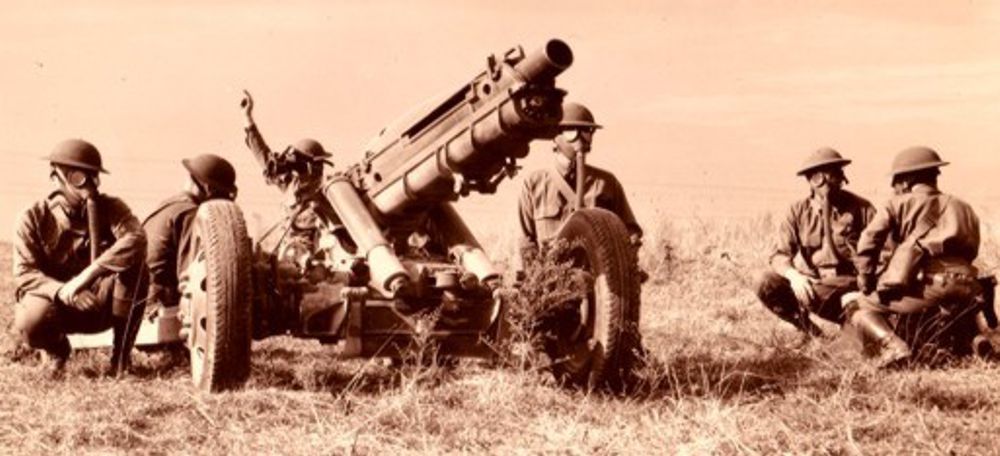
68th Field Artillery practicing with gas masks in Ft. Knox, Kentucky
National Archives Photo
Indiana War Memorial
Shoulder Patch of the 32nd Div.
http://en.wikipedia.org/wiki/32nd_Infantry_Division_United_States)

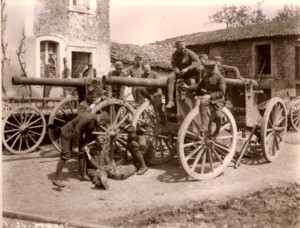
Men of Batteries A & B, 103rd Field Artillery, formerly 26thDiv., alive after battle of Seichepiey, playing with young lioness mascot. Rangeval, France.
National Archives Photo 13319 Group 111 Courtesy of Indiana War Memorial.
"Catching a little nap under cover of their camouflaged guns, before moving their position under cover of the night, 313th Field Artillery, 155th Brigade."
National Archive Photo courtesy of Indiana War Memorial Archives
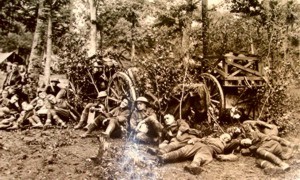
Chester Elmer Shutz, Sergeant, Co. K. 335th Infantry, 84th Div., Vanderburgh County, Indiana
Arrived in France and transferred to Co. K., 28th infantry, 1st Division. Drilled a maneuver round and on the 29th of October 1918, hiked to the front in the Argonne, resting at day, and hiking at night, under shell fire. For on November 2nd, Co. K. was the advance guard and pushed into German territory in the front ranks, attacking point being Sedan.
Killed in action November 7 as a first-rate Sergeant in the Mouzon engagement on the circle of hills surrounding Sedan. Just before sailing, he had been operated on for appendicitis at Camp Sherman in July 1918.
Clifford Carl Schomber, 32nd Div., Ripley County, Indiana
“The French chose the 32nd Division for two drives on Soissons, the only American Division that fought with the French. They were known all over France as the “Les Terribles Division”. Broke the German lines on all six fronts, winning our insignia on the battlefields of France, “The Arrow Piercing the Line”.
Out of the six months on the front, we were relieved for eleven days; then we remained within hearing distance of heavy guns.
16,000 rounds were fired by our brigade on the Argonne in the last barrage. When firing ceased at the 11th hour of the 11th day of the 11th month.”
Lost 14,000 out of 25,000.
Phillip J. McCauley, Captain, Artillery, Tippecanoe County, Indiana
Entered service in April 1918. Stationed at Ft. Snelling, Minn. Sent to Ft. Sill, Okla., where he acted as an instructor. Transferred to Camp Mills, N. Y. Saw active service in France. Was decorated by General Pershing for brave and gallant fighting in the Luneville sector, France. While in the battle of Chateau-Thierry, his horse, which he brought from St. Paul, was shot from under him. He had a narrow escape from death. In August 1918, he was appointed Secretary of the Officers’ Artillery School at Bordeaux, France, the largest training school for artillery officers in the world. Born at Lafayette. Ind., July 9, 1882, son of Mrs. Annie E. McCauley. Wife is Genevieve McCauley. Home is St. Paul, Minn.
Glenn V. Eytchison, Pvt., Co. C., 89th Div., Marion County, Indiana
Argonne Forest: Under shellfire for 108 days. When under fire with his squad, he noticed the guns had ceased around him. He found he was all-alone, all those around him had fallen.
Harry A. McColm, 1st Lt., Cavalry, Tippecanoe County, Indiana
Entered service in May 1917, stationed at Ft. Riley, Kas., and attached to the 20th Cavalry. Was later transferred to Camp Logan, Tex., and Camp Shelby, Miss., where he was transferred to the 77th Field Artillery. Sent to Camp Greene, N, C., a mobilization camp for the 4th Division. Left for overseas service in April 1918. Saw active service around the Verdun sector, and while there, was under heavy fire. A shell exploded just twenty feet from him and a heavy thicket was all that saved him. On the last of October 1918, he received orders to report to the 2nd A. T. C., at Tours for training as an aerial observer, and while there, the armistice was signed. Transferred to Embarkation Camp at Bordeaux, France, as a staff officer of the Inspector General’s Dept. Saw active service in the Aisne-Marne, St. Mihiel and Meuse Argonne Offensives. Born at Gaston, Ind., April 16, 1895, son of Emerson McColm. Wife is Florence King McColm.
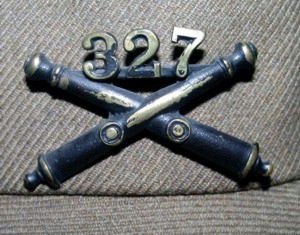
327th Field Artillery Collar Pin
Indiana War Memorial Archive
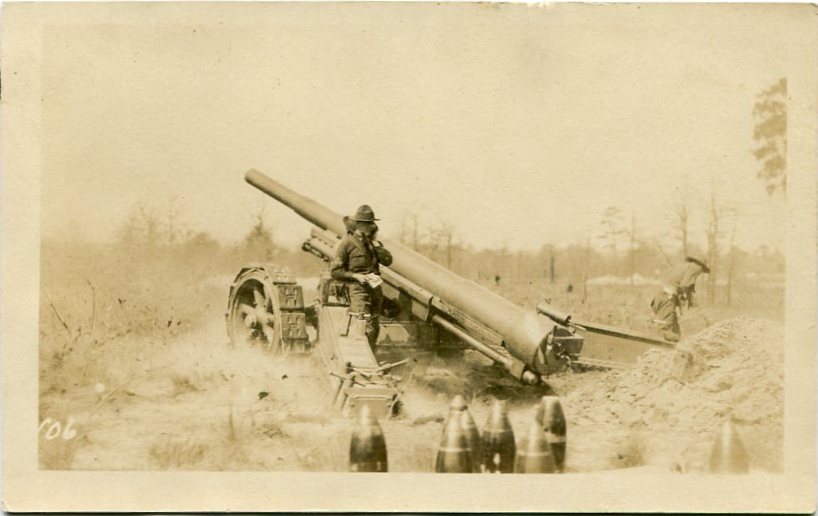
Real-photo postcard of a photograph of a U.S. Army M1918 155 mm Grande Puissance Filloux (GPF) artillery gun after having been fired by soldiers standing around the gun at the firing range at Fort Bragg, N.C., around the 1920s [circa 1920s].
US Army Signal Corps Photo
"An American battery of howitzers ready to fire upon the Huns from the ruins of a town in France. This was one of the first United States official photographs of the American advance in the Argonne, a district that is not all forest by any means, but comprises much-cultivated territory and many towns and villages that have been wrecked by ruthless German fire."
US Signal Corps Photo, America's War for Humanity
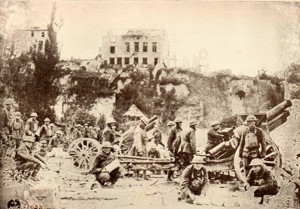
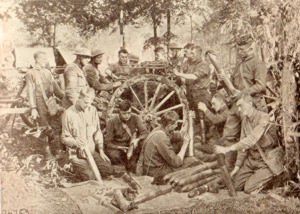
"Men of the 313th US Field Artillery cleaning and polishing 75-millimeter shells to be sent over to the Huns at night. Dirty or rusted shells are dangerous to use."
US Official Photos, America's War For Humanity
Ora Dayton Catlin, Pvt, Field Artillery, Hamilton County, Indiana
Gold Star (Died of tuberculosis of the spine)
“Participating in a field meet, while running a footrace he fell, while trying to win the race. He was never conscious after being taken from the field. Lay unconscious from Monday until Thursday. A good boy, having joined Church three years before entering the service, attending Sunday school regularly. He belonged to the Eagle Lodge at Elwood. A kind and loving son and a true friend.”
Mr. and Mrs. George Catlin, R. R. 1, Atlanta, Indiana
Edward Andrew Snyder, 139th Field Artillery, Decatur County, Indiana
“Enlisted in Co. B., 4th Indiana Infantry, June 22, 1917. Mobilized at amp, Wolf, Rushville, Indiana August 5, 1917. Arrived at Camp Shelby, August 22, 1917, and August 1, 1917 the 4th Indiana was reorganized into heavy Field Artillery known as the 139th Field Artillery Motorized, using oversize 155 mm Howitzers. We trained in Shelby until September 22, 1918. We left for overseas, going to Camp Upton, Long Island. Left Hoboken, New Jersey October 6, 1918 on English ship, HMS Cedric and after being torpedoed October 16 and damage slightly, landed at Liverpool, England, October 17, 1918. Left South Hampton England for France, October 21, 1918, landing at Cherbourg, October 22, 1918. Going on to American Artillery Training Camp, Camp DeMeucore, arriving November 9, 1918. Arrived at Camp Pontauezen, December 1, 1918, getting ready to sail for (illegible), Brest, France. President (Wilson) arrived Brest on December 13, the 139th included in the bunch to meet him. Sailed from Brest, France December 15, 1918 on the USS George Washington, arrived at Hoboken, New Jersey, December 22, from there to Camp Meredith New Jersey, and then to Fort Benjamin Harrison Indiana, were we were demobilize January 15, 1919.”
Oscar Jesse Hendricks, Private, Field Artillery, Marion County, Indiana
“….seen some hard times while in service”
- June 12 - April 30, 1918, Sudan, Pauta
- July 6 - July 28, 1918 Soissons
- September 9 - September 22, 1918 St. Mihiel
- November 1 - November 11, 1918 Meuse-Argonne

Photograph of the 113th Field Artillery Regiment, 30th Division, on March 20, 1919. Photograph taken just after the 113th F.A. had returned from overseas duty in Europe during World War I [Photograph by: Holladay, Newport News, Virginia.]
US Signal Corps photo
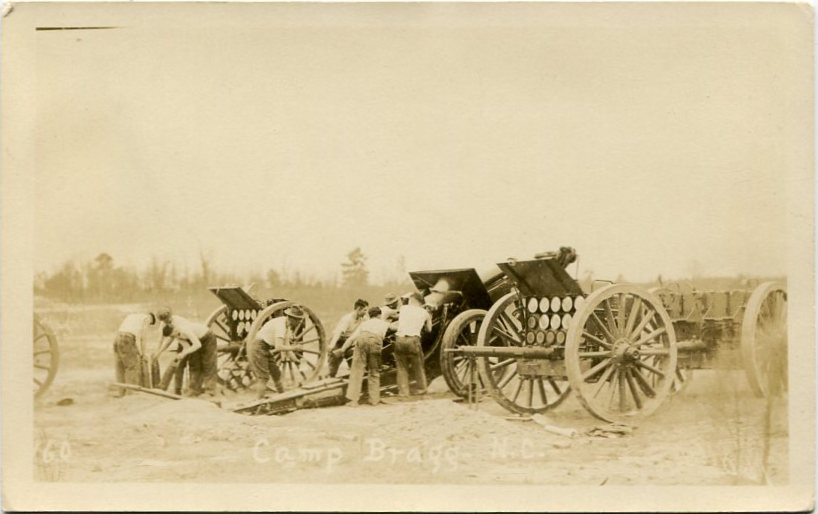
Real-photo postcard of a photograph of a U.S. Army M1918 155 mm Grande Puissance Filloux (GPF) artillery gun being fired on the firing range at Fort Bragg, N.C., around the 1920s [circa 1920s].
US Army Signal Corps photo
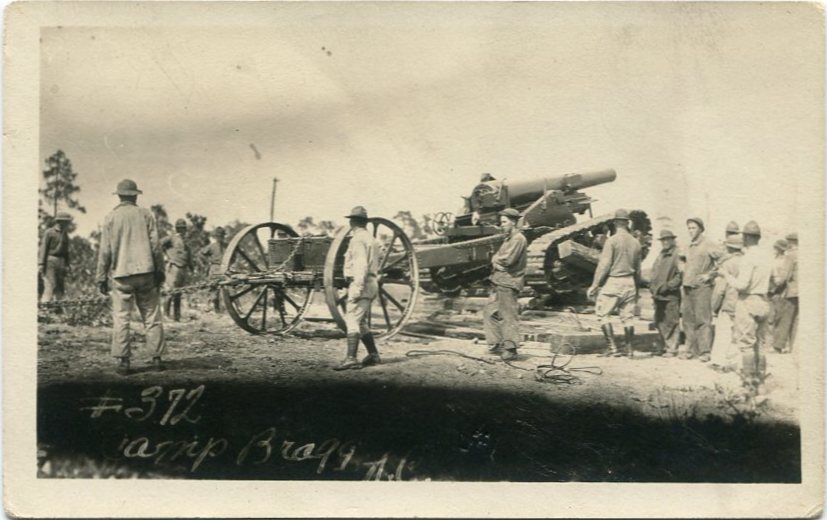
Real-photo postcard of a photograph of an unidentified field artillery crew standing around an artillery gun on the firing range at Camp Bragg, N.C., taken between 1918 US Signal Corps photo
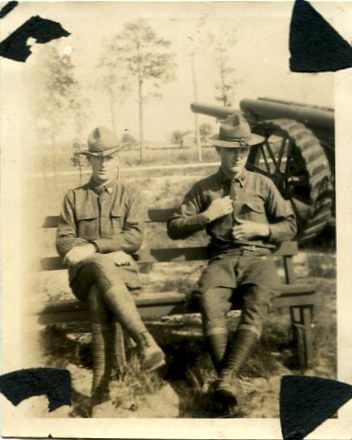
Snapshot of two unidentified U.S. Army soldiers sitting outside on a wooden bench, with a large artillery gun behind them, outside at the field artillery training area at Fort Bragg, N.C., around the 1920s [circa 1920s] [Photograph printed by: Finley’s Studio, Dalton, Georgia].
US Signal Corps photo
![FAHowitzer Real-photo postcard of a photograph of an unidentified U.S. Army soldier with Battery C, 5th Field Artillery Regiment, sitting on the end of the raised-up barrel of a M1918 240mm howitzer gun at Camp Bragg, N.C., taken between 1918 and 1922 [circa 1918-1922].](https://wwvets.org/wp-content/uploads/2020/08/FAHowitzer.jpg)
Real-photo postcard of a photograph of an unidentified U.S. Army soldier with Battery C, 5th Field Artillery Regiment, sitting on the end of the raised-up barrel of an M1918 240mm howitzer gun at Camp Bragg, N.C., taken between 1918 and 1922 [circa 1918-1922].
US Signal Corps photo
Myron Rundle Bone, Captain, Field Artillery, Tippecanoe County, Indiana
What was your attitude towards military service before the war?
“I believe in universal military service. I was a member of the National Guard myself, and think the militia should better be trained, organized, and equipped.
I firmly believe that every American young man should have the benefits of military training and should be required to enroll and train with military reserve. Physically unfit should be trained for home service in an emergency. ‘In a time of peace prepare for war’ and the BEST preparation America could make today is a well trained, equipped, and organized reserve. The alternative is the entrance into THE League of Nations, without reservations, IMMEDIATELY. This alternative was vetoed by the electorate at the polls in the election of Senator Harding to the Presidency.
Frank Carlton Loring, Captain, Ordnance Department, Officers Reserve Corps, Grant County, Indiana
Member of the Carnegie Expedition of 1915-16, circumnavigating the South Pole.
Drilled for the Spanish-American War, in an Indiana Regiment.
Wounded in a shell explosion on October 31, 1917, at the Aberdeen proving ground, Aberdeen, Maryland. Hospitalized at the Post Hospital, Fort Howard, Maryland; Walter Reed hospital, Washington, DC and USA General hospital #21, Denver, Colorado.
Volunteered in engineer officers Reserve Corps, April 10, 1917, Washington, DC.
- Joined Engineers Corps, August 1917, helping to build Camp Meade.
- Was commissioned 1st Lt., Ordnance Officers Reserve Corps, September 1917, Washington, DC
- Was transferred from Aberdeen proving grounds, Aberdeen, Maryland to the Construction Department, Quartermaster Corps, Washington, in May 1918.
- Later transferred to the cannon section of the Ordnance Department, May 1918, Washington, DC.
- Was in charge of the experimental work, the first of its kind in the United States, for the production of cannon by casting the metal.
- Was first to advocate the introduction of magnetic analysis into the building of cannons; the methods purpose being the detection of flaws in large, raw pieces of cast steel.
- Did all of the preliminary testing of new explosive “velocity” at Denver, Colorado, the reports, being the first ever made, were submitted to United States government. The explosive is being further perfected and has not yet been adapted for military purpose. It has notable characteristics. Efforts are being made to have it adapted by the United States government.
Captured German "Minnie" 10" trench Mortars
Field Artillery guns under camouflage
This diagram was prepared by Major General Leonard Wood, as chief of staff of the United States army, showing how the field artillery of the United States compares with that of the other great nations.
The Topeka State Journal 1914
Captain Harry S Truman
Commander Battery D, 129th Field Artillery
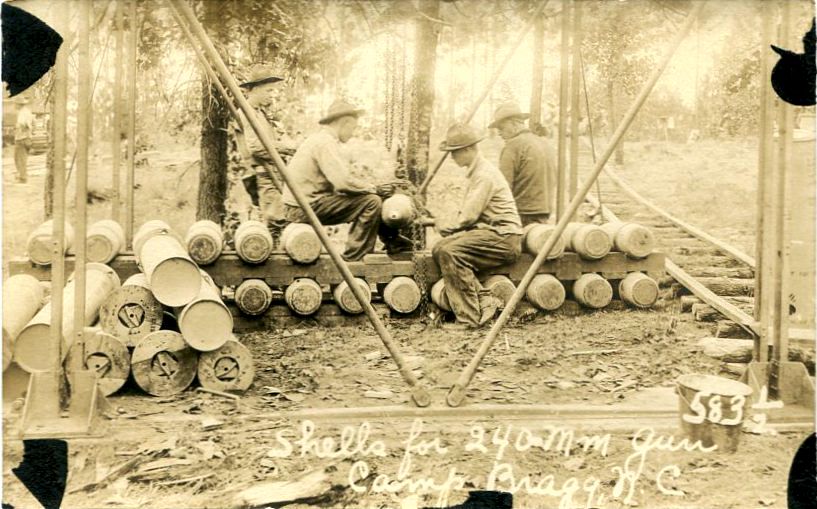
Real-photo postcard of a photograph of unidentified U.S. Army soldiers moving large shells of an M1918 240mm howitzer gun by a pulley chain along a rail track for carts at Camp Bragg, N.C., taken between 1918 and 1922 [circa 1918-1922].
US Signal Corps Photo
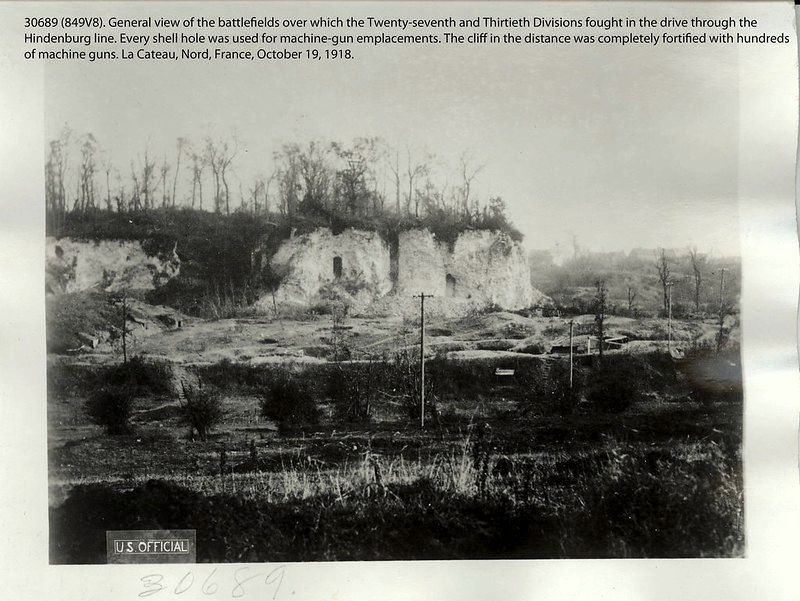
General view of the battlefields over which the 27th and 30th Divisions fought in the drive through the Hindenburg line, taken at Le Cateau-Cambrésis, France, on October 19, 1918. Every shell hole was used for machine-gun emplacements. The cliff in the distance was completely fortified with hundreds of machine guns.
US Army Signal Corps Photo
Alfred Hogston, 9th Div., Infantry, Grant County, Indiana
“About October 1917, I helped organize state militia Co. at Marion, Grant County, Indiana and was made 2nd Lt. Later on, about November 20, 1917, I resigned from the State Militia to aid in the organization of the 2nd Indiana Field artillery, which was a National Guard organization and which the War Department had promised to induct immediately into the federal service.
Helped organize the Battery of 2nd Indiana Field Artillery, at Marion, Indiana. Enlisted and sworn into 2nd Indiana Field Artillery (National Guard), at Indianapolis, Indiana on May 6, 1918. Enlisted as a Private and was commissioned a Captain in 2nd Indiana Field Artillery on May 6, 1918, and assigned to Battery E. As an officer of the 2nd Indiana Field Artillery, I entered the government artillery school at West Point, Kentucky about June 3, 1918, and remained there until about July 12, 1918. Have never been discharged from the 2nd Indiana Field Artillery and still a member of this unfortunate and mistreated Regiment. This Regiment, organized at a great deal of expense to the promoters, who worked for only the deepest patriotic motives, never came nearer to federal service then to secure from the government, permission for its officers to enter into work at the Government’s Artillery School at West Point, Kentucky.
Two others who worked hard to organize a Battery for the 2nd Indiana Field artillery at this place were Milton Matter and Orion O. Schick.”
Signed Alfred Hogston, 407 Nelson Street, Marion, Grant County, Indiana.
Harry Robert Hall, Major, Batt. C, 139th Field Artillery, 38th Div., Grant County, Indiana
“Organized Co. E, 4th Indiana Infantry starting in April 1917; which Co. left Marion Indiana September 5, 1917, after being in federal service from August 5, 1917 during this first month at National Military Home for D. V. S.
Upon being transferred to Heavy Field Artillery on October 1, 1917, was made battery commander of C Battery, 139th Field Artillery, which was a consolidation of E Co. from Marion, Indiana, and F Co. from Bedford, Indiana, 4th Indiana Infantry.
Served with battery the entire period until January 1919 except for three months when he attending the School of Fire at Fort Sill, Oklahoma, and six weeks while with the Advance Detachment of the 38th Div. in moving overseas.”
William Raymond Harper, Infantry, Vanderburgh County, Indiana
Served as an 8" shell inspector prior to his enlistment.
“The following amount of ammunition was hauled by the motor Battalion while at the front.
- 75mm shells 82,035
- 155mm 74,328
- Powder Charges 17,326
- Fuses 120,446
- Primers 12,860
- Small arms caliber 30 cartridges 2,082,400
- Small arms caliber 45 cartridges 650,000
- Strips for Machine-gun 115,000
- Detonators for 6” Newtons 5,000
The following are the Divisions, Armies, Corps, which this Brigade has been engaged since their arrival at the front.
Armies Corps Divisions:
I II 89, I I 92, I V 37, II V 32, II II (CAC, French) 79, II II 33, II II 33, II XVII 33, II IX 33, II VII 33, II VI 33, II II 33
Clyde Erasmus Scott, Batt. C, 123rd Field Artillery, Grant County, Indiana
Goldstar: Died Feb. 25, 1918 of wounds received from accidental causes in the line of Military duty, at Camp Logan, Houston, Texas:
“Clyde Erasmus Scott, while working at his trade as a bottle blower in Chicago Heights, Illinois, hearing the call of his country, enlisted in Co. M, 6th Illinois Infantry, April 12, 1917 and was sent to Camp Lowden, Springfield, Illinois for training. While General Joffre of France was visited the United States, Clyde's Co., being the best drilled and all the men being near of size, were chosen as General Joffre’s bodyguards while he was in Springfield and at Lincoln’s town. This, Clyde considered a great honor. He enjoyed Camp life in Springfield very much, as well as all through his military training. The first of July, 1917, his Co. was sent to Belleville, Illinois, to guard Scott's Aviation Field. Part of his regiment was sent to Guard duty at East St. Louis during the riot there; and about November 1st, 1917 his whole regiment was sent to Camp Logan, Houston, Texas, where he was transferred to a first-class Private, Battery C, 123rd Field Artillery. Here, Pete went through hard military training and was very anxious for overseas duty and was ready to go, when he came to his death on February 25, 1918. After the usual military service, his remains were sent to his grief-stricken parents, Mr. and Mrs. Will Scott at Fairmont, Indiana. His body arrived there March 2 and his funeral was preached Sunday, March 3 by the Rev. McRouse and Rev. Perviance at the Christian Church, after which he was laid to rest in beautiful Park Cemetery, Fairmount, Indiana.”
Robert S. Middleton, Infantry, Marion County, Indiana
A fellow soldier was killed by his side, by an exploding shell, at St. Mihiel. He was covered with earth, rendered unconscious and had to be dug out, but was not injured.
James Edward Connolly, Corporal, FA, RD, Allen County, Indiana
Corporal James Edward Connolly, should by right to be placed on the Goldstar list, having contracted the ailments which resulted in his death while in service at training camps. He came home with a health impairment and resumed his employment at the knitting Mills for a few weeks, but soon resigned and sought less confining employment, which he found at the Square Deal Garage as a repairman. He broke down completely in March, and was under treatment from that time on and through about the first of August, when he was admitted to Irene Byron Hospital, this (Allen) county where he died, September 29, 1919, of tubercular complications.
He was 31 years of age and had been employed from the age of 14 at the Knitting Mills, until leaving Ft. Wayne for the training camp. A bride and seven-year-old daughter have removed from Ft. Wayne, the wife having remarried, November 1919, John Welty, of Kendallville, Indiana. Connolly's nearest relatives are therefore his brother, whose address is given. ( 802 Wilt Street, Ft. Wayne, Indiana)
“Died February 17, 1919, of spinal meningitis developed January 3 from exposure, due to weakened condition. Had pneumonia when a child and was seventy-five pounds overweight when inducted into the army.”
Joseph Lewis Hyatt, 2nd Lt. AEF, Ripley County, Indiana
“Departed Europe from Pauillac, France. “Pauillan was the part from which Lafayette sailed with his fleet to the aid of Washington during the American Revolution. At Bordeaux, the troops visited the cave and castle of the Black Prince of English History.”
Drewry Kassebaum, Quartermaster Corps, Marion County, Indiana
“wasn't lucky enough to get overseas…”
The whole time I was in the service, except while in first training at Fort Benjamin Harrison, I was in utility work at Camp Taylor, Kentucky, in charge of operations branch, (light and power, refrigeration, water, sewers, and steam). Received orders to go over, but the order was rescinded on the eve of embarkation, on request old Commanding Officer at Camp Taylor and I returned to former duty.
War Record of the Patterson Boys, Grant County, Indiana: Sons of Mrs. F. O. Ury
Her four sons enlisted and served during the entire period of the war in France. Two were wounded, one gassed. All returned to the United States. One son is still in the service.
Cpl. Marion F. Patterson, Grant County, Indiana, Battery B, 15th Field Artillery
Enlisted April 12, 1917, Trained at Syracuse, New York. Sailed late in November 1917. Went to the Front early in the Spring of 1918 when the big drive started. Was in Active Service in Many Big Drives. Was in the Argonne Battle, St. Mihiel, Beanla Woods. In the 2nd Div. They Battled 40 Days to Keep the Huns from Paris. On November 3 was wounded severely by high explosives in the right chest. Was in the death ward at Nantes, France for many days. Arrived in the United States on January 31, 1919. Married, May 12, 1919.
Pvt. Theodore W. Patterson, Grant County, Indiana, Co. F, 63rd Infantry
Enlisted in 1916 in 17th Cavalry. Transferred from 17th Cavalry to 5th Div. Ammunition Train in December 1917. Went across this division in May 1918. Was in two major offenses, Champagne Front, St. Mihiel Front, and smaller ones. Went to hospital on October 20, 1918, but not wounded. Was one of the 250 men picked for a Presidential Honor Guard in Paris. Guard for President Wilson at his Paris Mansion and the Peace Commission, from February 12 to July 8, 1919. Is now with the 13th Infantry at Camp Mills, Long Island, New York. Was home on furlough, July 1919, arrived back to Camp Mills, sent from there to Washington, DC, and is now serving with the 63rd Infantry at East Potomac Park, Washington, DC. He has enlisted again and is now going to school.
Pvt. Earl H. Patterson, Grant County, Indiana, Battery E, 44th Field artillery
Enlisted April 5, 1916, at Columbus, Ohio. Trained at Columbus Barracks, Ohio. Sailed from Hoboken, New Jersey, August 18, 1917. Trained at Camp De Mailly, France from September 14, 1917, until April 12, 1918. Participated in Major offenses at Lorraine Front, Champagne Front, St. Mihiel Front, and numerous smaller engagements both offensive and defensive. Received battery citations. Wounded by a piece of shrapnel in the right leg, sent to the hospital for treatment. Sailed for the United States on January 26, 1919. Received honorable discharge from the service at Camp Jackson, Columbia, South Carolina.
- With 8th French Army from April 13 - June 30, 1918
- With 4th French Army from July 4 - August 13, 1918
- With 1st American Army from September 1 – 21, 1918
- With the 2nd American Army from September 22 until the armistice.
This regiment (44th) fired more than 5000 tons of channels at the Germans from April until the close of offenses at the front.
